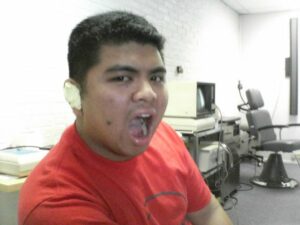In part 1 of this series about Dr. Bob Oliveira we talked about the implications of his 1986 patent showing that a piece of tubing must be glued to a silicon earplug to prevent the ear phone from falling out of the silicon plug- low tech but very effective. Without the glue, we would not have people being able to wear earphones for their MP3 players that did not fall out of their ears.
Bob Oliveira discovered something else that now seems obvious to our field and has had important clinical ramifications. What is it? That we need to open our mouths when we have earmold impressions taken for custom hearing protection and in-ear monitors (and also to have an improved fit for power hearing aid fittings).
In 1992, Bob and his colleagues wrote an article for Ear and Hearing (“A look at ear canal changes with jaw motion”, Oliveira, R., Hammer, B., Stillman, A., et al., Ear and Hearing, 13, 6, 464-466) in which they discussed using MRIs to assess the changes in dimensions of the outer ear canal. The medial (internal) portion of the ear canal is surrounded by bone and does not change, but the lateral (outer) portion of the ear canal is surrounded by pliable cartilage and so does have some play in its shape.
Specifically, Oliveira et al. examined how the front-back and top-bottom dimensions would change as the jaw is opened. The rear part of the jaw (the condyle) is adjacent to the front part of the ear canal. Opening one’s mouth allows the condyle to slide forward, thereby allowing the front part of the ear canal to also move forward.
An earmold impression taken with the mouth closed would have a different shape than one taken when the mouth was open, or even ajar.
Bob and his colleagues found that as the mouth was opened, the front part of the ear canal did indeed move forward by up to 25% of the entire diameter. This typically amounted to about 1-2 mm. They found no changes in the other dimensions. That is, the back part did not move, nor did the top-bottom dimension- just the front (anterior) dimension moved forward.
The implications for high-fidelity sound and a good acoustic seal are obvious. When listening to an MP3 and earphone encased in a custom-made earmold, unless the impression was taken with the mouth open, there would be a potentially poor seal in the front part of the ear canal, with a subsequent loss of the bass notes. In audiological terminology, a vent would have been unintentional created that would allow the lower frequency sounds to escape, resulting in a “thinner” sound.
Taking the earmold impression with the patient’s mouth open would alleviate this problem – there would be a larger front-back dimension in the earmold impression than if the mouth had been closed.
This instruction of “open your mouth during the earmold impression” is based on this anatomical finding (the condyle of the jaw moves forward when your mouth is open) and is designed to ensure the best possible bass response. This is also a common instruction for taking earmold impressions on hard of hearing people who require high-gain hearing aids.
There is some debate on whether we should be using bite blocks held between the teeth to ensure a constant (and optimal?) ear canal front-back dimension during the earmold impression process. I have no solid data on this. but have done thousands of impressions on performing artists (and their security staff) over the years, and based on returns and complaints, I don’t think that the bite blocks are necessary. I have tried it both ways- bite block, and having the client just keep their mouth slightly ajar- and found no differences. This is true of actual measurements of the earmold in the front-back dimensions with both techniques, and complaints of poor seal from the clients once they receive the in-ear monitor product and try them out.
So which of these three pictures in this post is of Bob Oliveira. Hint- he’s the one with his mouth closed! Well, he is smiling, but in a closed-mouth sort of way…

Is this Bob Oliveira?








